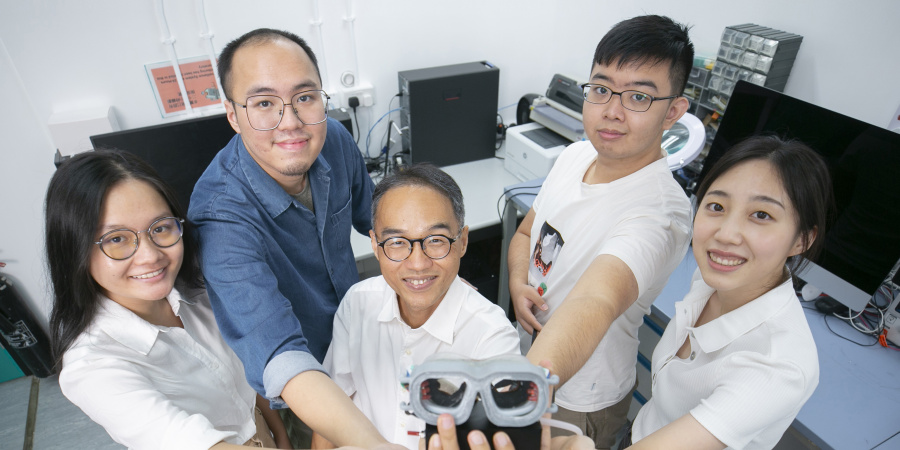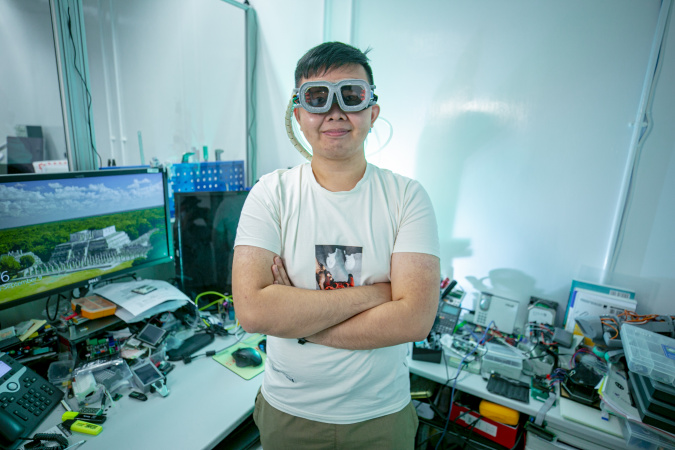Wearable Device O_Oley Shines Light on Glaucoma Prevention
An ounce of prevention is worth a pound of cure. This saying stays true, especially when it comes to one specific eye condition—glaucoma. Widely known as the silent thief of sight, glaucoma is notorious for being undetectable, irreversible, and could slowly progress into vision loss or blindness. Motivated by a shared goal of saving the sight for people who are most vulnerable to glaucoma, a HKUST research team invented an easy-to-use non-invasive wearable device effective in preventing the progression of glaucoma—O_Oley.
Led by Prof. David LAM and supervised by Dr. Stanley LEUNG from the Department of Mechanical and Aerospace Engineering, the team comprises four engineering students, namely Kin-Nam KWOK (Year 5, PhD in Mechanical Engineering), Minji SEO (Year 1, PhD in Mechanical Engineering), Kwun-Chung CHAN (Year 4, BEng in Mechanical Engineering), and Yuen-Yin LEUNG (Year 3, BEng in Mechanical Engineering). The team’s invention won them the Hong Kong national leg of the James Dyson Award, injecting £5,000 into their research project, enabling them to patent the design and kick-start a start-up to improvise the invention.
Glaucoma is a group of eye conditions that damage the optic nerve head, where nerves responsible for sending visual signal from the eye to the brain originate from. The damage is often caused by sustained build-up of internal eye pressure, known as the intraocular pressure (IOP). For patients diagnosed with glaucoma, reducing IOP is a proven method of treatment to date.
Glaucoma causes progressive vision loss over time and is the second-leading cause of blindness worldwide. Despite its prevalence, preventive therapies against glaucoma are still lacking. O_Oley is developed as a readily accessible physio-therapeutic device for the general public who cares about their eye health. The clinical version is developed to release the eye stresses and to slow down the damages originated from aging-induced tissue stiffening.
From concept to practise
Tired eyes are comforted by massages, and the effectiveness is enhanced with hot towels. However, they are only effective to the periocular region and insufficient for relaxing the intraocular tissues. The team conducted scientific investigations and developed the concept into the O_Oley systems, which allows users to enjoy benefits of warm corneal stretching for daily ocular healthcare. It progressively improves ocular-tissue compliance and minimizes damages from intraocular stresses.
O_Oley comprises a corneal tissue compliance improvement (CTCI) system and an ocular cell rejuvenation (OCR) system. The CTCI system regulates the goggle chamber pressure and increases the chamber temperature to massage the corneal tissue by non-contact means, while the OCR system utilizes activation light at specific wavelengths and infra-red irradiation to energize intra-cellular activities, as well as to promote blood circulation within the ocular region.
“O_Oley is like the ‘hot yoga’ for your eyes. It lowers your eye pressure by stretching the ocular surface and allows it to relax under a controlled heated environment,” Kin-Nam says, explaining that the structure of the eyes is similar to that of a balloon. When the surface gets stiffer and tenser, air pressure builds up from within. O_Oley is designed to reduce that eye stress, thereby halting the progression of glaucoma.
Faced by the inconvenient truth that everyone can be at risk for glaucoma, O_Oley is designed to serve not only diagnosed patients, but also people with a higher number of glaucoma risk factors, such as the elderly, individuals with high eye pressure, high myopia or hyperopia, and those with a family history of glaucoma. With a therapeutic sensation as gentle as compressing one’s eyes with a warm towel, the device’s usage can be expanded to cover all who suffer from eye strain associated with digital and urban lifestyles.
The team is now taking steps to refine their earlier iteration and to develop a more market-ready prototype. They intend to speed up the development process by inviting more talented students to join the team.
A pleasant side track
In the course of research, the team stumbled upon an unexpected discovery and celebrated a moment of serendipity. Although O_Oley was developed with the primary objective of lowering IOP, it was also proven effective in helping the eyes stay moist.
“To our surprise, O_Oley works quickly to relieve dry eye symptoms,” says Kin-Nam. “While lowering the IOP takes time, the eye’s moisturizing index goes up almost instantaneously after using O_Oley. It offers immediate relief to the scratchy and irritating sensations of the eyes.”
Moving forward, the team will continue searching for the significance of surprises and coincidence. Combined with a little curiosity and perseverance, unplanned discovery can be transformed into a new product feature benefiting a new group of users.
A timely recognition
The research process was not always smooth sailing, the team underwent a period when progress was barely keeping pace with their effort. While recognizing that measuring the device’s effectiveness and verifying results took repeated experiments and patience, they were inevitably discouraged when the trial participants’ IOP remained constant at the beginning.
“At that time, we progressed by inch as months go by. Frankly, we once thought about giving up when developing the prototype,” says Kin-Nam. “The Dyson Award came as a timely assurance. It was such an honor to see our innovation win buy-ins and recognition. We bounced back and gained renewed confidence to make things turn again.”
Fortunately, the research outcome did not let them down. From there, the team witnessed a gradual decline in trial participants’ IOP, proving O_Oley to be viable in lowering IOP, offering a novel non-invasive therapeutic pathway for glaucoma prevention.
Apart from calibrating parameters affecting the device’s efficacy, the team also focused on creating a positive user experience by optimizing comfort level. They initiated multiple rounds of prototype refinement and addressed the fitting issue by making the device smaller, lighter, and more ergonomic.
ONE is better than one
Being a multidisciplinary team with members from different fields of engineering, the team strings together their expertise and unites under one common vision. They go further than divvying up the tasks, they lean on each other to build collective knowledge, challenge one another to think from different perspectives, and fully integrate each member’s insights and contribution to create the best possible solution.
“The synergy we have within the team is magical,” says Minji. “It’s never easy to find good partners to be on the same team. We are very lucky to have found each other, we work day in and day out hoping to achieve the same goal.”
The team champions in inclusive communication and creates an open culture where each member feels comfortable contributing their ideas and opinions.
“We have gone through several cycles of design modification and the process is no doubt challenging. I think our root as one team was what made the winning possible,” says Kwun-Chung. “We have nurtured an environment where everyone is encouraged to speak their mind and share ideas, no matter how bizarre that idea might sound. There’s no fear, no judgment, and that drives self-motivation.”
Unblock curiosity with proper guidance
Standing on the shoulders of giants, the team sees further by building on the knowledge and discoveries made by Prof. Lam and previous researchers. “The inspiration and ideas given by Prof. Lam were very important. Over the past 10 years, he has been laying down the fundamental research grounds related to the eyes’ biomechanics. Without his insights and experiences, we would have easily led ourselves down the wrong path,” says Kin-Nam thankfully.
Curiosity is also an essential trait of a successful research team, but it can be a two-edged sword if lack proper coaching. Prof. Lam and Dr. Leung strike an intricate balance between giving clear direction and allowing creative freedom when guiding the team. They act as reliable expert consultants and at the same time provide constructive feedback to avoid derailment of the project.
“One of the biggest characteristics of this team is that they are incredibly curious. It motivates them to delve deeper and unearth more insights, and they don’t give up until they have an answer,” says Dr. Leung with a smile. “Our job is to channel their curiosity toward the right direction so they can bring to life their collective innovation.”
The team treasures the hands-on learning experience, the trust and empowerment from their supervisors, and the opportunity given to be part of the research journey. “This is my first research internship, so the expectation is more like I get told what to do, but it turns out that, on top of the guidance, our supervisors give us a lot of freedom and flexibility to be with our own curiosity,” says Yuen-Yin in appreciation. “I personally would like to thank Dr. Leung for bringing me onto the team after knowing about my interest in biomechanics. It is a very unique experience.”
Never give up
Driven by a deeply ingrained sense of purpose, the team intends to persist until they achieve the overarching goal of creating a wearable device effective in preventing glaucoma.
“Even if O_Oley didn’t generate positive trial results, we believe we would have taken an alternative route and developed another device to achieve the same purpose. Because right from the beginning, our goal is not to commercialize a product, but to create something that serves glaucoma patients, and every step we take is oriented to that goal,” says Kin-Nam. “Because one day, we might be the beneficiary of our own invention, who knows?”
Related link:
- SENG news (September 8, 2022): Two HKUST Research Teams Awarded the James Dyson Award 2022


